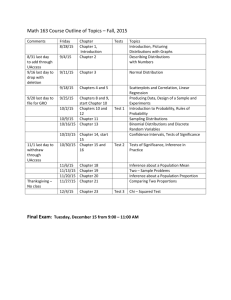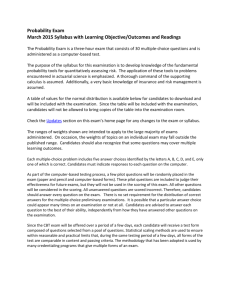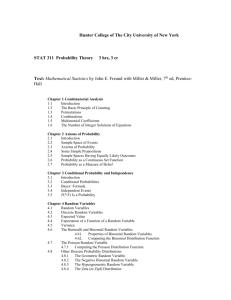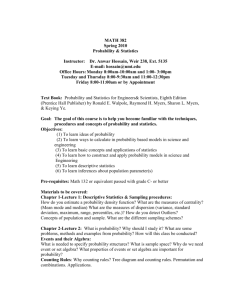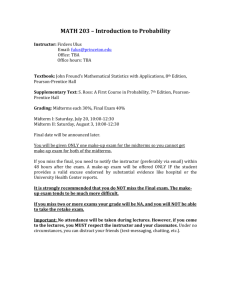STT490-001: Actuarial Exam 1/P Prep Course, Spring 2015
advertisement
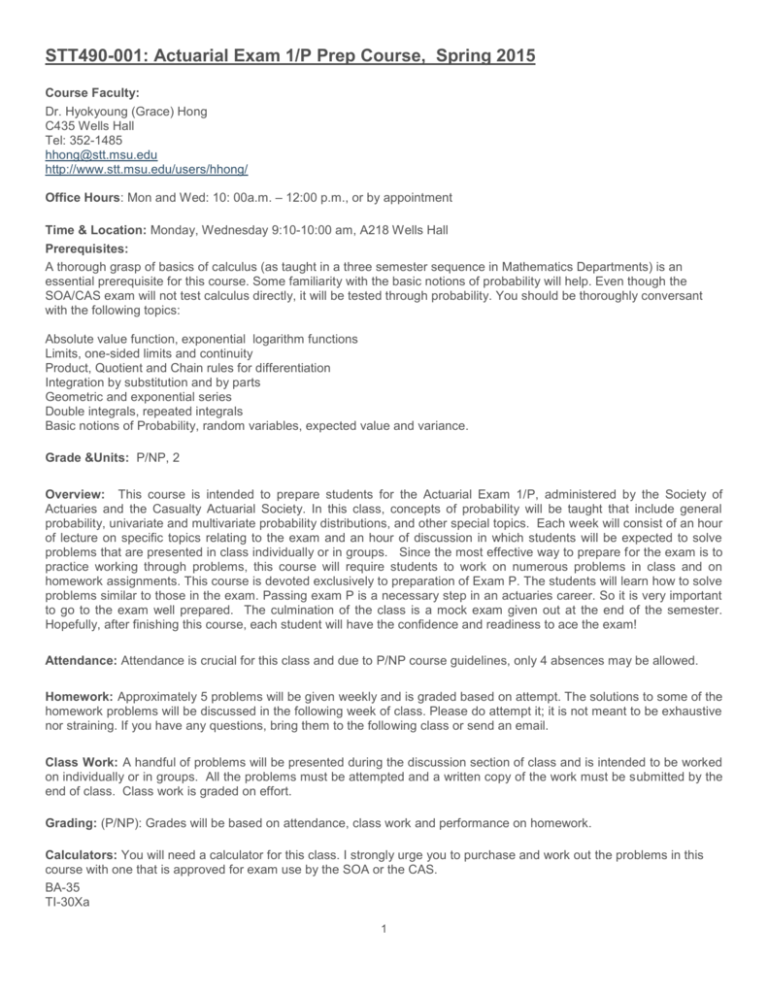
STT490-001: Actuarial Exam 1/P Prep Course, Spring 2015 Course Faculty: Dr. Hyokyoung (Grace) Hong C435 Wells Hall Tel: 352-1485 hhong@stt.msu.edu http://www.stt.msu.edu/users/hhong/ Office Hours: Mon and Wed: 10: 00a.m. – 12:00 p.m., or by appointment Time & Location: Monday, Wednesday 9:10-10:00 am, A218 Wells Hall Prerequisites: A thorough grasp of basics of calculus (as taught in a three semester sequence in Mathematics Departments) is an essential prerequisite for this course. Some familiarity with the basic notions of probability will help. Even though the SOA/CAS exam will not test calculus directly, it will be tested through probability. You should be thoroughly conversant with the following topics: Absolute value function, exponential logarithm functions Limits, one-sided limits and continuity Product, Quotient and Chain rules for differentiation Integration by substitution and by parts Geometric and exponential series Double integrals, repeated integrals Basic notions of Probability, random variables, expected value and variance. Grade &Units: P/NP, 2 Overview: This course is intended to prepare students for the Actuarial Exam 1/P, administered by the Society of Actuaries and the Casualty Actuarial Society. In this class, concepts of probability will be taught that include general probability, univariate and multivariate probability distributions, and other special topics. Each week will consist of an hour of lecture on specific topics relating to the exam and an hour of discussion in which students will be expected to solve problems that are presented in class individually or in groups. Since the most effective way to prepare for the exam is to practice working through problems, this course will require students to work on numerous problems in class and on homework assignments. This course is devoted exclusively to preparation of Exam P. The students will learn how to solve problems similar to those in the exam. Passing exam P is a necessary step in an actuaries career. So it is very important to go to the exam well prepared. The culmination of the class is a mock exam given out at the end of the semester. Hopefully, after finishing this course, each student will have the confidence and readiness to ace the exam! Attendance: Attendance is crucial for this class and due to P/NP course guidelines, only 4 absences may be allowed. Homework: Approximately 5 problems will be given weekly and is graded based on attempt. The solutions to some of the homework problems will be discussed in the following week of class. Please do attempt it; it is not meant to be exhaustive nor straining. If you have any questions, bring them to the following class or send an email. Class Work: A handful of problems will be presented during the discussion section of class and is intended to be worked on individually or in groups. All the problems must be attempted and a written copy of the work must be submitted by the end of class. Class work is graded on effort. Grading: (P/NP): Grades will be based on attendance, class work and performance on homework. Calculators: You will need a calculator for this class. I strongly urge you to purchase and work out the problems in this course with one that is approved for exam use by the SOA or the CAS. BA-35 TI-30Xa 1 BA II Plus TI-30X IIS or TI-30XIIB BA II Plus Professional TI-30 XS Multi View or TI-30XB MultiView Probability Exam (excerpted from the SOA website) The Probability Exam is a three-hour exam that consists of 30 multiple-choice questions and is administered as a computer-based test. The purpose of the syllabus for this examination is to develop knowledge of the fundamental probability tools for quantitatively assessing risk. The application of these tools to problems encountered in actuarial science is emphasized. A thorough command of the supporting calculus is assumed. Additionally, a very basic knowledge of insurance and risk management is assumed. A table of values for the normal distribution is available below for candidates to download and will be included with the examination. Since the table will be included with the examination, candidates will not be allowed to bring copies of the table into the examination room. Check the Updates section on this exam’s home page for any changes to the exam or syllabus. The ranges of weights shown are intended to apply to the large majority of exams administered. On occasion, the weights of topics on an individual exam may fall outside the published range. Candidates should also recognize that some questions may cover multiple learning outcomes. Each multiple-choice problem includes five answer choices identified by the letters A, B, C, D, and E, only one of which is correct. Candidates must indicate responses to each question on the computer. As part of the computer-based testing process, a few pilot questions will be randomly placed in the exam (paper and pencil and computer-based forms). These pilot questions are included to judge their effectiveness for future exams, but they will not be used in the scoring of this exam. All other questions will be considered in the scoring. All unanswered questions are scored incorrect. Therefore, candidates should answer every question on the exam. There is no set requirement for the distribution of correct answers for the multiple-choice preliminary examinations. It is possible that a particular answer choice could appear many times on an examination or not at all. Candidates are advised to answer each question to the best of their ability, independently from how they have answered other questions on the examination. Since the CBT exam will be offered over a period of a few days, each candidate will receive a test form composed of questions selected from a pool of questions. Statistical scaling methods are used to ensure within reasonable and practical limits that, during the same testing period of a few days, all forms of the test are comparable in content and passing criteria. The methodology that has been adopted is used by many credentialing programs that give multiple forms of an exam. Learning Outcomes Students should be able to use and apply the following concepts in a risk management context: 1. General Probability (15-30%) • Set functions including set notation and basic elements of probability • Mutually exclusive events • Addition and multiplication rules • Independence of events • Combinatorial probability • Conditional probability • Bayes theorem / Law of total probability 2. Univariate probability distributions (including binomial, negative binomial, geometric, hypergeometric, Poisson, uniform, exponential, gamma, and normal) (30-50%) • Probability functions and probability density functions • Cumulative distribution functions • Mode, median, percentiles, and moments • Variance and measures of dispersion 2 • Moment generating functions • Transformations 3. Multivariate probability distributions (including the bivariate normal) (30-45%) • Joint probability functions and joint probability density functions • Joint cumulative distribution functions • Central Limit Theorem • Conditional and marginal probability distributions • Moments for joint, conditional, and marginal probability distributions • Joint moment generating functions • Variance and measures of dispersion for conditional and marginal probability distributions • Covariance and correlation coefficients • Transformations and order statistics • Probabilities and moments for linear combinations of independent random variables References • A First Course in Probability (Eighth Edition), 2009, by Ross, S.M., Chapters 1–8. • Mathematical Statistics with Applications (Seventh Edition), 2008, by Wackerly, D., Mendenhall III, W., Scheaffer, R., Chapters 1-7. • Probability for Risk Management, (Second Edition), 2006, by Hassett, M. and Stewart, D., Chapters 1–11. • Probability and Statistical Inference (Eighth Edition), 2009, by Hogg, R.V. and Tanis, E.A., Chapters 1–5. • Probability and Statistics with Applications: A Problem Solving Text, 2010, by Asimow, L. and Maxwell, M. • Probability: The Science of Uncertainty with Applications to Investments, Insurance and Engineering 2009, by Bean, M.A., Chapters 1–9. Other Resources The candidate is expected to be familiar with the concepts introduced in “Risk and Insurance”. Tables for Exam P/1 Exam P/1 Sample Questions and Solutions (1–153) Risk and Insurance Course Outline: Week 1/12: Introduction, counting techniques, compound events, Venn diagram, trees, permutation, conditional probability, multiplication rule, Bayes rule... Week 1/19: continued.. Week 1/26: Discrete & continuous random variable (Single R.V.), probability distribution function, cumulative distribution function, properties of expected values and variance Week 2/2: Discrete distributions: Binomial, Poisson Week 2/9: Discrete distributions: Geometric, Negative Binomial, Hypergeometric Week 2/16: Continuous distribution: Uniform, Exponential… Week 2/23: Normal distribution & Central Limit Theorem Week 3/2: Multivariable – joint discrete and continuous distributions, marginal distributions Week 3/16: Conditional Expectation & Variance, Covariance, Correlation Week 3/23: Sum of random variables Week 3/30: Transformations, Moment Generating Functions Week 4/6: Order Statistics: Maximum and minimum of independent R.V Week 4/13:. Miscellaneous Topics, Practice Problems 1-2 Week 4/20: Practice Problems 3-4 Week 4/27: Take-home Practice Problem Exam Information: http://soa.org/education/exam-req/edu-exam-p-detail.aspx 3 Michigan State University Academic Calendar Aug 2014 S M T W 2014 to 2015 Sep 2014 T F S 1 2 S Oct 2014 M T W T F S 1 2 3 4 5 6 S M T W T F S 1 2 3 4 3 4 5 6 7 8 9 7 8 9 10 11 12 13 5 6 7 8 9 10 11 10 11 12 13 14 15 16 14 15 16 17 18 19 20 12 13 14 15 16 17 18 17 18 19 20 21 22 23 21 22 23 24 25 26 27 19 20 21 22 23 24 25 24 25 26 27 28 29 30 28 29 30 26 27 28 29 30 31 M T T F S S M T W T F S S M T T F 1 2 3 4 5 6 1 2 3 31 Nov 2014 S W Dec 2014 1 Jan 2015 W S 2 3 4 5 6 7 8 7 8 9 10 11 12 13 4 5 6 7 8 9 10 9 10 11 12 13 14 15 14 15 16 17 18 19 20 11 12 13 14 15 16 17 16 17 18 19 20 21 22 21 22 23 24 25 26 27 18 19 20 21 22 23 24 23 24 25 26 27 28 29 28 29 30 31 25 26 27 28 29 30 31 S M T W T F S S M T W T F S S M T W T F S 1 2 3 4 5 6 7 1 2 3 4 5 6 7 1 2 3 4 8 9 10 11 12 13 14 8 9 10 11 12 13 14 5 6 7 8 9 10 11 15 16 17 18 19 20 21 15 16 17 18 19 20 21 12 13 14 15 16 17 18 22 23 24 25 26 27 28 22 23 24 25 26 27 28 19 20 21 22 23 24 25 29 30 31 26 27 28 29 30 S M T W T F S S M T S 1 2 3 4 5 6 30 Feb 2015 Mar 2015 May 2015 S M T W Apr 2015 Jun 2015 T F S 1 2 Jul 2015 W T F 1 2 3 4 3 4 5 6 7 8 9 7 8 9 10 11 12 13 5 6 7 8 9 10 11 10 11 12 13 14 15 16 14 15 16 17 18 19 20 12 13 14 15 16 17 18 17 18 19 20 21 22 23 21 22 23 24 25 26 27 19 20 21 22 23 24 25 24 25 26 27 28 29 30 28 29 30 26 27 28 29 30 31 31 Important dates Classes Begin MLK Day - no classes Spring Break Classes End Reading Period – no classes Final Exams Commencement Mon., 1/12 Mon., 1/19(Make-up day will be Mon., 4/27) Mon., 3/9 - Fri., 3/13 Mon., 4/27 (Make-up day for MLK Day) Tues., 4/28 - Wed., 4/29 Thu., 4/30 - Wed., 5/13 Fri., 5/15 4
